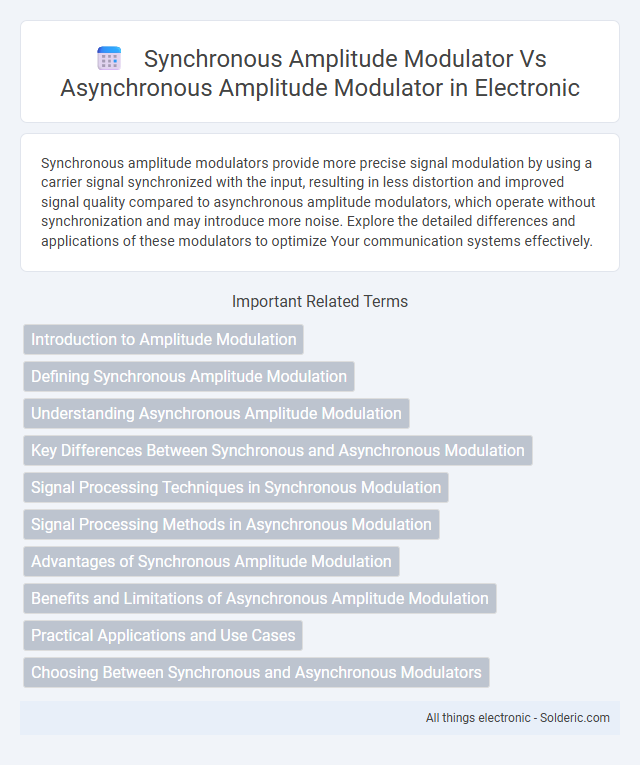Synchronous amplitude modulators provide more precise signal modulation by using a carrier signal synchronized with the input, resulting in less distortion and improved signal quality compared to asynchronous amplitude modulators, which operate without synchronization and may introduce more noise. Explore the detailed differences and applications of these modulators to optimize Your communication systems effectively.
Comparison Table
| Feature | Synchronous Amplitude Modulator | Asynchronous Amplitude Modulator |
|---|---|---|
| Operating Principle | Carrier wave and message signal are synchronized | Carrier wave and message signal operate independently |
| Signal Synchronization | Requires phase and frequency synchronization | No synchronization required |
| Modulation Quality | High fidelity with minimal distortion | Generally lower fidelity, possible distortion |
| Complexity | More complex circuitry due to synchronization | Simpler circuitry, easier implementation |
| Applications | Communications requiring precise modulation, e.g., digital data transmission | Basic AM broadcasting and simple signal modulation |
| Power Efficiency | Higher power efficiency due to better modulation control | Lower power efficiency |
| Noise Susceptibility | Lower noise sensitivity because of synchronization | Higher noise sensitivity, prone to interference |
Introduction to Amplitude Modulation
Amplitude modulation (AM) involves varying the amplitude of a carrier wave to transmit information, with synchronous amplitude modulators using a carrier synchronized to the message signal for precise modulation and reduced distortion. Asynchronous amplitude modulators operate without carrier synchronization, resulting in simpler designs but increased distortion and spectral inefficiency. Synchronous modulators provide improved signal fidelity and better performance in communication systems requiring high accuracy.
Defining Synchronous Amplitude Modulation
Synchronous amplitude modulation (AM) precisely aligns the modulating signal with the carrier wave's phase and frequency, enabling accurate detection and improved signal-to-noise ratio compared to asynchronous AM. This synchronization reduces distortion and enhances demodulation efficiency, making it ideal for applications requiring high fidelity and stability. Understanding synchronous AM helps you optimize communication systems by ensuring coherent modulation and demodulation processes.
Understanding Asynchronous Amplitude Modulation
Asynchronous amplitude modulation operates without a synchronized carrier signal, resulting in variable phase and frequency relationships between the modulating signal and the carrier. This modulation technique is useful in scenarios where maintaining strict timing synchronization is challenging or unnecessary, impacting the stability and spectral characteristics of the transmitted signal. Understanding asynchronous amplitude modulation allows you to optimize communication systems that handle non-coherent signal processing or environments with timing uncertainty.
Key Differences Between Synchronous and Asynchronous Modulation
Synchronous amplitude modulators use a carrier signal that is phase-locked to the input signal, ensuring precise timing and minimal distortion, while asynchronous amplitude modulators operate without this phase synchronization, often leading to signal degradation or timing mismatches. The key difference lies in synchronization control; synchronous modulation maintains consistent phase relations, which improves signal fidelity and reduces noise, whereas asynchronous modulation can introduce phase errors and increased spectral sidebands. Your choice between synchronous and asynchronous amplitude modulation impacts the overall signal quality and application suitability, especially in communication systems requiring high precision.
Signal Processing Techniques in Synchronous Modulation
Synchronous amplitude modulators employ precise carrier signal synchronization, enabling coherent demodulation and improved signal-to-noise ratio during signal processing. This technique ensures accurate phase alignment, reducing distortion and enhancing the fidelity of the recovered signal in communication systems. Your choice of synchronous modulation can significantly optimize signal integrity compared to asynchronous methods that lack such phase coherence.
Signal Processing Methods in Asynchronous Modulation
In asynchronous amplitude modulation, signal processing methods focus on independent timing between the carrier and modulating signals, leading to potential phase and frequency discrepancies that require robust demodulation techniques. These methods often involve envelope detection and adaptive filtering to accurately extract the amplitude variations amidst timing misalignments. Your system's performance depends on effectively managing these challenges to maintain signal integrity without relying on synchronized clocks.
Advantages of Synchronous Amplitude Modulation
Synchronous amplitude modulation offers superior signal fidelity and reduced distortion compared to asynchronous amplitude modulation, ensuring clearer and more accurate transmission of the original message. Its ability to maintain phase coherence between the carrier and modulating signals minimizes spectral inefficiency and improves overall noise resistance. Your communication system benefits from enhanced sensitivity and improved signal-to-noise ratio, making synchronous amplitude modulators ideal for high-quality audio and data applications.
Benefits and Limitations of Asynchronous Amplitude Modulation
Asynchronous amplitude modulation offers simpler circuitry and better tolerance to frequency variations compared to synchronous amplitude modulation, making it suitable for applications where signal synchronization is challenging. However, it suffers from lower signal-to-noise ratio and increased distortion due to the absence of a coherent reference signal. Your choice between these modulators should consider the trade-off between implementation complexity and modulation quality.
Practical Applications and Use Cases
Synchronous amplitude modulators excel in communication systems requiring high fidelity signal transmission, such as professional audio broadcasting and radar systems, due to their precise carrier synchronization. Asynchronous amplitude modulators find practical use in simpler, low-cost applications like amplitude shift keying (ASK) in digital communication and envelope detection in AM radio receivers where carrier synchronization is not critical. The choice between synchronous and asynchronous modulators depends largely on the trade-off between signal quality requirements and system complexity in various industrial and consumer electronics.
Choosing Between Synchronous and Asynchronous Modulators
Choosing between synchronous and asynchronous amplitude modulators depends on the application's requirements for signal fidelity and complexity. Synchronous modulators provide precise carrier synchronization, resulting in lower distortion and better spectral efficiency, ideal for high-performance communication systems. Asynchronous modulators offer simpler implementation and cost-effectiveness but may suffer from higher distortion and phase noise, making them suitable for less demanding applications.
Synchronous amplitude modulator vs asynchronous amplitude modulator Infographic

 solderic.com
solderic.com